Article
Obtain business insight with CLT's article
On July 3, 2025, the “2025 Smart Port Technology &
Industry Global Forum” was held at BPEX(Busan Port Int'l Exhibition & Convention Center) in Busan, jointly hosted by the Korea
Maritime Institute (KMI) and the International Association of Ports and Harbors
(IAPH). At this event, key industry leaders including Oscar Pernia, CTO of
NextPort.Ai, and Tommi Rinta-Kartano, Senior Manager at Kalmar, shared their
insights on future port technologies and operational strategies. Among the
notable presentations was “Integrated Smart Solutions for the Next-Generation
Port” by Lucy Lee, Senior Consultant at CyberLogitec (CLT), which is summarized
here.
This session emphasized a crucial shift in focus: from
smart terminals to smart ports—and from current systems to next-generation
solutions. The term “next-generation” is often used in two contexts: when an
industry reaches the limit of its efficiency gains, or when rapid environmental
change renders existing systems obsolete. The port industry today faces both.
The Wave of Change in Port Operations
Ports around the world are confronting the dual
challenges of legacy system limitations and sweeping shifts in the global
environment. For example, data collected from multiple port authorities reveals
that fully automated terminals saw a 30% increase in throughput over the past
year, while conventional terminals experienced a 1.9% decrease. Profitability
for automated terminals also rose by 22%, demonstrating their operational and
financial superiority.
Meanwhile, the rapid upscaling of vessels continues.
Orders for ships exceeding 20,000 TEU are surging, and shipping alliances now
demand berth productivity equivalent to 31 cranes or more. Yet most individual
terminals—aside from a few mega-hubs—struggle to accommodate such scale,
resulting in transshipment cost burdens and weakened port competitiveness.
Berthing delays caused by infrastructure shortages further drive the need for
collaboration and integrated operations among terminals.
In this context, ports require an operational paradigm
that goes beyond legacy automation and isolated optimization. They must build a
connected digital ecosystem—centered on automation, intelligence, and interoperability.
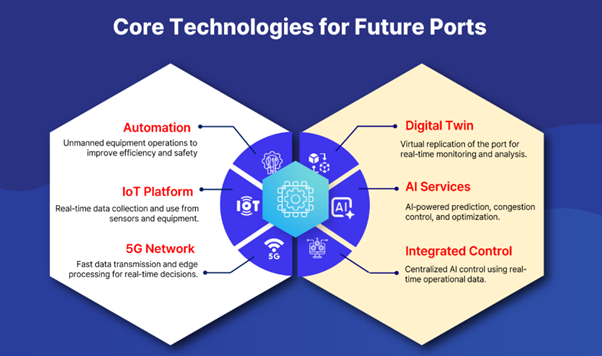
Core Technologies for a Digital Port Ecosystem
The technologies enabling this transformation fall
into two main categories: (1) automation and infrastructure technologies, and
(2) cognitive technologies that leverage the data generated by automation.
For instance, unmanned equipment movements are
transmitted via 5G to an IoT platform, which collects and analyzes data in real
time—enabling machine-based cognition rather than human-driven monitoring.
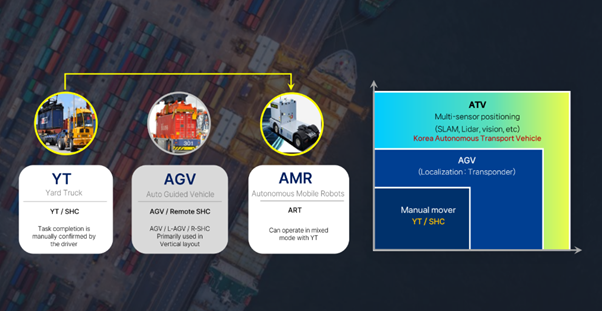
Equipment Automation and AMR Adoption
Significant advances have already been made in the
automation of terminal equipment, especially in horizontal transport. Traditional
manned vehicles have evolved into AGVs guided by transponders, and now into
autonomous mobile robots (AMRs) equipped with multi-sensors for environmental
awareness. A key benefit of AMRs is their ability to operate safely in mixed
traffic with manual equipment or external trucks, allowing for leapfrogged
deployment without intermediate infrastructure.
Currently, multiple terminals including Busan New Port
are conducting AMR pilot programs. Globally, many ports (including Busan) have
achieved full automation, while others like Ningbo and Shenzhen remain
partially automated. In some regions—especially India and Latin
America—retrofit automation is gaining traction, enabling ports to upgrade
existing equipment (e.g., remote STS and yard cranes, new horizontal transport
units) into fully automated systems.
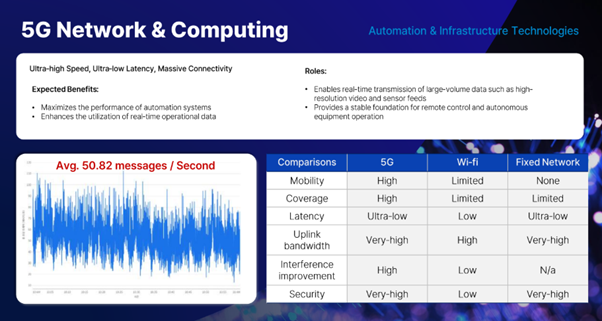
Such automation demands infrastructure support. As
shown in the referenced chart, more than 50 messages per second are exchanged
between terminal systems and equipment—not including inter-equipment
communication. This level of messaging requires high-speed, ultra-reliable
network infrastructure. Among available options, 5G outperforms Wi-Fi and wired
networks in mobility, coverage, and security, making it foundational for
digital port transformation.
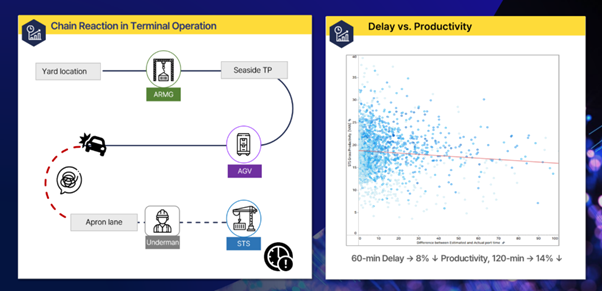
Data-Driven Optimization with IoT and AI
5G-based communication enables real-time control
between automated systems and a centralized IoT platform, which comprises
rule-based control, event monitoring, analytics engines, and a data
center—laying the groundwork for data-driven decision-making.
In port operations, bottlenecks at a single point
often impact the entire workflow. Data from a six-month operational analysis
revealed that a one-hour vessel delay reduced crane productivity by 8%, and a
two-hour delay by 14%. To address such inefficiencies, Digital Twin technology
replicates the physical port in a virtual space for real-time monitoring and
operational simulation. Combined with AI, Digital Twins can go beyond
visualization and support predictive simulations.
The Role of AI in Real-Time Optimization
Conventional TOS (Terminal Operating Systems) include
optimization logic, but these are based on fixed rules and limited
adaptability. Port operations are dynamic, with constant changes in equipment
status and work schedules—making real-time optimization difficult with
traditional systems. AI, however, excels in processing complex variables and
providing predictive insight.
While AI can analyze and forecast data, it still
requires execution through connected systems. This is where intelligent
integrated control systems come into play—serving as the neural network that
executes AI decisions across IoT platforms, automation equipment, and sensors.
Future Vision of Port Operations
In the future, terminals will be operated with fully
automated, 5G-connected equipment, enabling unmanned, around-the-clock
operations with minimal human intervention. AI-enabled platforms will optimize
container yard planning, berthing schedules, and maintenance forecasting.
Operators will be able to simulate operations via
virtual terminals, pre-test scenarios, and detect equipment failures in
advance. These AI-driven routines will create a predictive operations model,
shifting ports from reactive to proactive management.
While full automation is already maturing globally, AI-driven operations are still in early stages. CLT is currently conducting a proof-of-concept project that demonstrates its real-world potential.
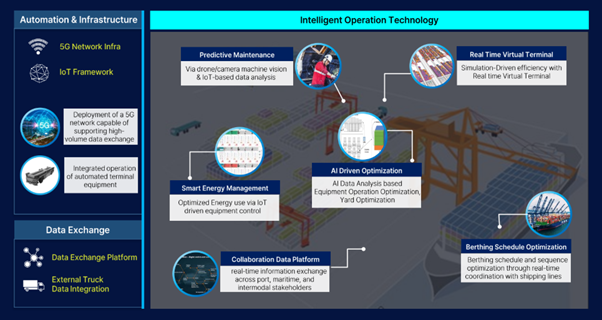
A Real-World AI Case: Dwell Time Optimization
One global terminal (with over 10 million TEU annual
throughput) was facing critical yard congestion. CLT developed an AI service to
predict container dwell time and optimize yard placement.
1.
A machine learning model
forecasts dwell time based on container history.
2.
The AI system uses this
prediction and TOS operational factors to assign yard positions.
3.
These assignments feed into a
continuous learning loop—Plan → Execute → Learn → Replan—improving prediction
accuracy over time.
The POC aims to reduce unnecessary yard shifting by up
to 30%. The AI prediction model:
·
Avoids concentration in
specific blocks,
·
Simulates bottlenecks
pre-execution,
·
Provides a real-time dashboard
for anomaly detection and performance monitoring.
This AI service is offered as an add-on to existing
TOS systems and can also be applied in multimodal environments, where seamless
data exchange is essential across stakeholders like carriers, inland transport,
and customs. Instead of full system integration, CLT proposes a lightweight
data linkage model using asynchronous messaging and APIs—preserving system
independence while enabling intelligent ecosystem-level optimization.
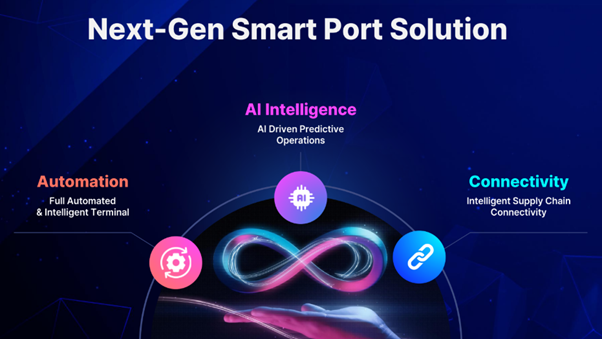
The future of smart ports lies in creating a digital
ecosystem—built not only on automation and intelligence, but on scalable,
interoperable, and add-on solutions. An ecosystem thrives when participants are
organically connected in a self-reinforcing structure, sharing both technology
and value.
As a key player in the smart port ecosystem, CyberLogitec
is committed to continuous collaboration and value creation through
future-ready solutions.
Author:
Lucy Lee, Terminal Business Consultant, CyberLogitec
Copyright
© 2025 CyberLogitec. All rights reserved. Unauthorized reproduction or use is
prohibited.


